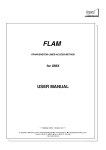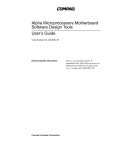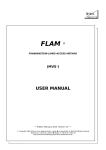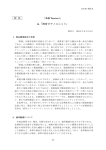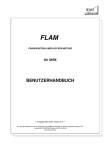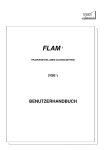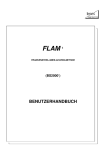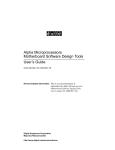Download FLAM®-sub (MVS)
Transcript
FLAM®-sub (MVS)
FRANKENSTEIN-LIMES-ACCESS-METHOD
USER MANUAL
— Edition May 2014 Version 4.5 —
© Copyright 1992-2014 by limes datentechnik® gmbh Louisenstraße 21 D-61348 Bad Homburg
Telephone ++49 6172 / 5919-0 Telefax ++49 06172 / 5919-39
http://www.flam.de http://www.limes-datentechnik.de
User Manual FLAM®-sub V4.5 (MVS)
© Copyright 2014 by limes datentechnik® gmbh
All rights reserved. The reproduction, transmission
or use of this document is not permitted without
express written authority.
Offender will be liable for damages.
Delivery subject to availability, right of technical
modifications reserved.
Preface
Preface
This manual describes how to handle the FLAM
subsystem in the IBM z/OS (OS/390, MVS)
operating system.
FLAM®-sub is an interface to FLAM® (MVS), the
compression and encryption utility, and may only
be used in conjunction with a license for FLAM®utility.
FLAM® (MVS) is described in the manual FLAM®
(MVS) V4.5, the encryption method is found in the
manual FLAM® & AES.
FLAM®, FLAMFILE® und limes datentechnik®
are international trademarks.
FLAM®-sub V4.5 (MVS)
Frankenstein-Limes-Access-Method
1
© 2014 by limes datentechnik gmbh
FLAM®-sub (MVS)
User Manual
Summary of c hanges
Summary of changes
Summary of changes 7 FLAM®-sub V4.5
This release is an adaption to the FLAM® (MVS)
utility V4.5.
It includes the following new features
-
KME=FKMEFILE
This key management extension routine reads a
key from a sequential file to encrypt/decrypt the
written/read data via the FLAM® subsystem.
The file may be of fixed or variable record length.
Trailing blanks are ignored.
The syntax of the key is the same as of parameter
CRYPTOKEY.
The file may be protected by RACF, so this is an
easy way for encryption/decryption without any
key-protocol.
-
License check
The subsystem modules are now included in the
FLAM® (MVS) LOAD library. There is an own license
check implemented avoiding using the FLAMsubsystem without a special license.
Summary of changes 6 FLAM®-sub V4.4
The Key Management Interface of FLAM (MVS) (->
manual FLAM (MVS) V4.x, ch. 3.5.5) is
implemented in this subsystem release:
A user written module is invoked when opening a
data set to provide FLAM-sub with a key for
encryption/decryption.
This
method
allows
an
automatic
encryption/decryption of files without any manual
user action. The key used is not shown in any
protocol.
Summary of changes 5 FLAM®-sub V4.3
Introducing crypto hardware CPACF in newer
hardware systems z9 and z10 allows FLAM®-sub
V4.3 to use these new routines for AES encryption.
FLAM®-sub V4.5 (MVS)
Frankenstein-Limes-Access-Method
1
© 2014 by limes datentechnik gmbh
Summary of changes
FLAM®-sub automatically checks the availability,
so no parameter other than CRYPTOMODE=AES is
needed.
Encryption by hardware increases perfomance and
decreases cputime. Up to 30 % may be. It depends
on the compression ratio, less compression
increases
time
savings.
Particularly
using
MODE=NDC, packing files without compression.
Summary of changes 4 FLAM®-sub V4.1
FLAM®-sub V4.1 benefits from the new and faster
implementation of the AES algorithm in FLAM
(MVS) V4.1.
Up to 50 % CPU time is saved using the new
AES routines in the subsystem.
Summary of changes 3 FLAM®-sub V4.0
FLAM®-sub V4.0 incorporates the
changes as compared with Version 3:
Support
of
AES-encryption
Encryption Standard)
following
(Advanced
Using parameter CRYPTOMODE=AES all data will
be encrypted in Advanced Encryption Standard
mode, introduced in FLAM (MVS) V4. Additional
information (hash-MACs) is stored in the FLAMFILE.
FLAMFILE split is supported
During output mode (writing records into an empty
file) a FLAMFILE can be split serially or in parallel
into several parts, subject to the settings of the
parameters
SPLITMODE,
SPLITNUMBER,
and
SPLITSIZE.
MODE=NDC
supported
2
Frankenstein-Limes-Access-Method
(No
Data
Compression)
is
Data compression can be suppressed using
MODE=NDC. Data are only formatted and, if
requested, encrypted. This saves CPU time with
data that do not compress efficiently
(e.g. FLAMFILEs or compressed image files). The
same security features are available as for
compressed data.
FLAM®-sub V4.5 (MVS)
© 2014 by limes datentechnik gmbh
Summary of changes
MODE=NDC is downwards compatible with FLAM
V3.x.
Summary of changes 2 FLAM®-sub V3.0
FLAM®-sub V3.0 incorporates the
changes as compared with Version 2:
following
MODE=ADC (Advanced Data Compression) is
supported
Using MODE=ADC all data are compressed by the
new ADC-algorithm of FLAM V3.x, the highest
efficient compression method for all data (even
non-structured data).
Loading VSAM-KSDS
IEBGENER, SORT)
with
a
Utility
(i.e.
Although utilities use a (sequential) DCB to open a
subsystem data set, it is now possible to load a
VSAM-KSDS file with FLAM®-sub.
Activate FLAM®-sub as a 'Started Task'
Start FLAM®-sub as a Started Task (S FLAM). So it
is not longer necessary to wait for an IPL to test
FLAM®-sub.
Summary of changes 1 FLAM®-sub V2.0
FLAM®-sub V2.0 incorporates the
changes as compared with Version 1:
following
VSAM accesses supported
The calling programs can be written either in
Assembler or in COBOL.
All logical VSAM accesses are supported by
FLAM®-sub V2.0, in both MOVE and LOCATE mode
and for both synchronous and asynchronous calls.
In particular, VSAM-KSDS commands are also
converted logically if an UPDATE is performed.
The index entries have been reduced to a
minimum and compressed, so that less space is
taken up in the memory and the overall
FLAM®-sub V4.5 (MVS)
3
Frankenstein-Limes-Access-Method
© 2014 by limes datentechnik gmbh
Summary of changes
performance is enhanced when VSAM files are
accessed.
Physical accesses via memory addresses (RBA) are
not supported.
Reading of uncompressed files supported
If the input is an uncompressed file, it can also
optionally be read via the subsystem.
In this case, the keyword parameter IG10 must be
entered for the subsystem:
//... DD ...,SUBSYS=(FLAM,IG10,'flam-parameter')
This parameter has no effect on compressed files.
TRACE function
A TRACE
purposes.
function
can
be
activated
for test
In this case, the keyword parameter TRACE must
be entered for the subsystem:
//... DD ...,SUBSYS=(FLAM,TRACE,'flam-parameter')
All function calls to FLAM, as well as ACB and RPL
of the calling program, are then traced in a file.
The trace file must be specified in the JCL. The
FLAM parameter 'MSGDDN=ddname' indicates the
DD name. If no name is specified the parameter for
the DEFAULT specification is used (generally
FLPRINT; cf. INST02 job of the FLAM utility).
The trace file can also be specified as a subsystem
file:
//FLPRINT
DD DSN=trace-file,SUBSYS=FLAM
New interface to FLAM utility
As of this version, all the required FLAM utility
modules are loaded as resident programs, in other
words the subsystem modules no longer need to
be linked to the utility. Consequently, no 'relinks'
are necessary if the license number for the utility
changes.
On the other hand, the load module library of
FLAM-utility now also needs APF authorization.
We recommend keeping the subsystem and utility
load modules in one library.
4
Frankenstein-Limes-Access-Method
FLAM®-sub V4.5 (MVS)
© 2014 by limes datentechnik gmbh
FLAM®-sub (MVS)
User Manual
C ont ents
Contents
Chapter 1
1.
FLAM® as a subsystem
1
Chapter 2
2.
Subsystem call
1
Chapter 3
3.
Preconditions
1
Chapter 4
4.
Principle of operation
1
Chapter 5
5.
Restrictions
1
5.1
In general
1
5.2
DCB calls (PS files)
2
5.3
ACB/RPL calls (VSAM files)
2
Chapter 6
6.
Parameters for FLAM®
1
Chapter 7
subsystem
7.
1
Parameters for controlling the
Chapter 8
8.
Subsystem messages
1
Chapter 9
9.
Installing FLAM®-sub
1
9.1
LINKLST and authorization
2
9.2
Subsystem start
3
10.
Examples
1
10.1
Input/output with catalogued files
1
10.2
FLAM® parameters and subsystem
2
10.3
Creating a new file
2
10.4
Temporary files
3
10.5
Other subsystems
3
10.6
Loading a VSAM-KSDS file
3
10.6.1
Load a real VSAM-KSDS file
4
10.6.2
Load a VSAM-KSDS file via an utility
4
10.7
TRACE function
5
10.8
FLAMFILE® split
7
10.8.1
Serial split
7
10.8.2
Parallel split
8
Chapter 10
FLAM®-sub V4.5 (MVS)
Frankenstein-Limes-Access-Method
1
© 2010 by limes datentechnik gmbh
Contents
2
Frankenstein-Limes-Access-Method
10.9
Encryption
9
10.9.1
Encryption via CRYPTOKEY parameter
9
10.9.2
Encryption via KME module
9
10.9.3
Encryption with FKMEFILE
10
FLAM®-sub V4.5 (MVS)
© 2014 by limes datentechnik gmbh
FLAM®-sub (MVS)
User Manual
Chapter 1:
F LAM® as a
subsystem
Chapter 1
FLAM® as a subsystem
1.
FLAM® as a subsystem
FLAM®-sub supports the subsystem interface of
the command language (JCL) in z/OS. Files can thus
be processed in compressed an encrypted form
without having to modify the associated programs.
The additional compression and decompression
steps which were necessary in the past can now be
dispensed with.
The calling program is not aware of any differences
as compared with the conventional mode of file
processing. It receives a record for a read call in
the same way as before, while for a write call the
data management system (DMS) receives the
record as usual. The subsystem decompresses
before reading and compresses before writing.
The compression results are similar to those of the
FLAM utility (approx. 70-90%).
The FLAM subsystem even enables programs to be
supported with file formats for which they were not
originally written, in other words the program and
the data formats can be separated from one
another.
The FLAM subsystem is loaded almost entirely in
the high address space (above 16 MB); only a
small tuning module for 24-bit addressing works in
the low address space. Since 24-bit addressing is
used for the DMS accesses to PS files, a memory
area corresponding to the length of one data
record is created in the low address space. FLAM
creates all work areas above the 16 MB limit, so
that the usual memory area is still made available
to the applications.
No changes are normally necessary in the calling
programs.
The compressed files created by the subsystem
(FLAMFILEs) can be decompressed by the FLAM
utility at any time, and all FLAMFILEs created by
the FLAM utility are accepted and processed
logically by the FLAM subsystem. The same applies
likewise to FLAMFILEs that are created/read via the
record interface of FLAM (see also manual for FLAM
V4.x).
FLAM®-sub V4.5 (MVS)
Frankenstein-Limes-Access-Method
1
© 2014 by limes datentechnik gmbh
FLAM®-sub (MVS)
User Manual
Chapter 2:
Subsystem call
Chapter 2
Subsystem call
2.
//ddname
//
//
Subsystem call
DD
DSN=filename,
DISP=OLD,
SUBSYS=(FLAM,'flam-parameter')
This call designates the cataloged file filename for
processing with the FLAM subsystem.
FLAM parameters can be specified in addition, in
the same way as with the FLAM utility.
Invalid parameters are rejected by FLAM as JCL
errors and the job they refer to is not even started.
The DD command is still verified by JES.
The catalog entry for the file is not modified by
FLAM. All entries such as the file name, the record
and block lengths, the volume, etc. remain
unchanged.
The files that must be processed with the FLAM
subsystem are thus still verified by the check
mechanisms, such as SMS and RACF.
There is no FLAM restriction on the number of files
that can be processed "simultaneously" by the
subsystem. The only restrictions are those imposed
by the system itself, such as the maximum amount
of available memory or the maximum possible
number of DD statements.
If files for which the SUBSYS specification in the DD
statement is not supported must be processed (for
example, JES files), the problem can be overcome
by specifying a FLAM parameter and a second DD
statement:
//ddname
//
//ddname1
//
DD SUBSYS=(FLAM,'FLAMDDN=ddname1'),
DCB=(LRECL=....,BLKSIZE=....)
DD SYSOUT=G,DEST=(.....),
DCB=(LRECL=80,.....)
Specifying a DD name ddname1 as a FLAM
parameter causes the subsystem to process the
file assigned by means of this name (in this case
by writing in it). This file must be specified in the
JCL. Similarly, ddname1 could be used as a
decompression input. The calling program, on the
other hand, uses the file assigned with ddname!
This method permits reading or writing in any file
(JES, RJE, other subsystems, magnetic tapes,
temporary files, etc.) which cannot otherwise be
processed with the usual method (see examples).
FLAM®-sub V4.5 (MVS)
Frankenstein-Limes-Access-Method
1
© 2014 by limes datentechnik gmbh
Subsystem call
Chapter 2
If DCB attributes are specified for ddname, FLAM
interprets them as values for the original
(uncompressed) file. DCB specifications for
ddname1 apply to the compressed file (the
FLAMFILE).
Record and block formats which are completely
different from one another can thus be set for the
original and compressed files depending on the
particular problem, in other words the subsystem
allows an application to use files that have
absolutely nothing in common with the entries in
the program (see examples) and that without the
subsystem might have to be converted.
If the FLAMFILE is accessed without a SUBSYS
specification, it behaves like a "normal" file, in
other words it can be read (copied, transferred) by
means of utilities or file transfer programs without
being decompressed!
Similarly, a FLAMFILE which is transferred by a file
transfer program can be read and processed via
the subsystem.
2
Frankenstein-Limes-Access-Method
FLAM®-sub V4.5 (MVS)
© 2014 by limes datentechnik gmbh
FLAM®-sub (MVS)
User Manual
Chapter 3:
P reconditions
Chapter 3
Preconditions
3.
Preconditions
FLAM must be installed on the computer (see
installation instructions) both as a utility (V4.0 or
higher) and as a subsystem.
Data records can be written, read, modified,
inserted or deleted. The data set organization may
be of PS or VSAM.
The accesses must be logical, in other words either
in sequential order or according to a key. Accesses
according to the RBA (relative byte address) of a
data record or an alternate index are not possible!
A DCB for PS files or an ACB for VSAM files can be
coded in the calling program. The programs (or
more precisely the file control block DCB) must be
stored in the low address space.
A FLAMFILE in KSDS format must have the same
structure as in the FLAM utility (see manual for
FLAM (MVS)), i.e.
Relative key position
Key length
Record length
bytes
Control interval size
depending on record
0
one byte longer than the
original
between 80 and 32760
any,
length
Although FLAM supports a wide range of record
length, please take care on performance views.
FLAM compresses a number of data records in a
row (depending on MAXR and MAXB parameter).
MAXB=64 means 64 KB of Data will be
compressed. Assume a compression rate of 90 %,
this will lead to a compression result of 6.4 KB
compressed data. If you had defined the VSAMKSDS-FLAMFILE like your original file (i.e. with
record size of 400 byte) FLAM has to write 17 VSAM
records for the compressed data, each with a new
built key. So has FLAM to read 17 records to
decompress one original record. So it is better to
define a larger RECSIZE for the FLAMFILE, in this
example you should use RECSIZE(7168 7168).
Note:
The runtime system of COBOL (PL/I, C) checks all
assigned VSAM files.
FLAM®-sub V4.5 (MVS)
Frankenstein-Limes-Access-Method
1
© 2014 by limes datentechnik gmbh
Preconditions
Chapter 3
The FLAMFILE must therefore be tuned to the
VSAM file type if COBOL programs are used: for
accesses to VSAM-ESDS it must also have been
created as ESDS, while for accesses to VSAM-KSDS
a KSDS-FLAMFILE must exist as well.
With Assembler programs, on the other hand, the
FLAMFILE and the original file need not necessarily
be of the same type (providing this is also
meaningful).
2
Frankenstein-Limes-Access-Method
FLAM®-sub V4.5 (MVS)
© 2014 by limes datentechnik gmbh
FLAM®-sub (MVS)
User Manual
Chapter 4:
P rinciple of operation
Chapter 4
Principle of operation
4.
Principle of operation
All the JCL specifications are checked before a
batch job is started by JES. The parameters for the
subsystem are transferred and verified by FLAMsub. If an error is detected, the DD statement is
rejected as a JCL error. In addition, a message is
output in the JCL list (see messages in examples
section). The job is thus only started if there are no
errors; otherwise it is aborted in the usual way.
An OPEN command call in the program causes a
connection to be set up to the FLAM subsystem.
FLAM-sub decides at this stage whether the file
must be compressed or decompressed. An open
input means decompression (read only), while an
open output means compression (write only). An
open I/O allows full I/Os to the FLAMFILE via the
key of the original records. At the same time, the
record and block lengths are taken from the calling
program (or from the DCB specifications in the JCL)
and - in the case of an open output - transferred to
the FLAM file header of the FLAMFILE (unless the
HEADER=NO parameter has been specified).
The FLAM parameters specified in the JCL are also
activated at the time of the open and the
compression/decompression
routines
set
accordingly.
All read and write accesses take place in
accordance with the specifications in the program.
Asynchronous
VSAM
calls
are
executed
synchronously by the subsystem, while return
codes are not returned (or the error routines
activated) until the CHECK call.
It makes no difference whether the file is accessed
by the program as BSAM, QSAM or VSAM. FLAMsub maps all calls to the currently available
FLAMFILE.
The record format can always be either variable or
fixed.
If an error occurs, the error routine remains active
in the calling program and is not overlaid by the
subsystem. The error return codes that are
returned by the subsystem correspond to those of
the DMS (see also 'MVS/DFP Macro Instructions for
VSAM Data Sets' for VSAM error codes), in other
words the error routines need not be modified; the
IEC ... messages of the DMS (MVS Message Library:
System Messages) are still traced if necessary.
Additional messages are output by FLAM-sub with
WTO,Routcde=11 for FLAM errors and subsystem
errors (see chapter 8, 'Subsystem messages').
They are documented both in the system log and
in the JCL list.
FLAM®-sub V4.5 (MVS)
Frankenstein-Limes-Access-Method
1
© 2014 by limes datentechnik gmbh
Principle of operation
Chapter 4
No other messages are generated (the FLAM
SHOW=ALL parameter of the utility has no effect).
A CLOSE for the file causes FLAM to close the
FLAMFILE and free all the work areas again that
were requested with the OPEN. New OPEN calls are
now allowed.
2
Frankenstein-Limes-Access-Method
FLAM®-sub V4.5 (MVS)
© 2014 by limes datentechnik gmbh
FLAM®-sub (MVS)
User Manual
Chapter 5:
Rest rictions
Chapter 5
Restrictions
5.
Restrictions
It is not normally necessary to modify the JCL as a
result of using the FLAM subsystem.
If specifications such as the record and block
lengths are omitted from the programs however
(utilities such as IEBGENER and SORT function in
this way), DCB specifications must be included in
the DD statement!
The usual principle whereby the values are
automatically taken from a catalog entry in such
cases does not work if a subsystem is used. An
OPEN routine only recognizes the actual presence
of a subsystem file and no longer accesses a
catalog entry (even if one exists).
5.1
In general
ADC
MODE=ADC is not allowed in update mode.
AES
AES-encryption of a VSAM-KSDS file is not allowed
DGD
Data Generation Groups must be specified with the
absolute name (FILE.G0004V00), not with the
relative name (FILE(+1)).
DISP
The DISP parameter in the DD statement (e.g.
DISP=NEW or DISP=(..., DELETE) cannot be
interpreted and thus has no effect.
All files that are assigned directly via FLAM-sub
(DSN=filename,
SUBSYS=FLAM)
must
be
cataloged.
If new files must be created, a second DD
statement can be used:
//ddname
//newfile
DD
DD
SUBSYS=(FLAM,'FLAMDDN=newfile')
DSN=...,
DISP=(NEW,CATLG),
UNIT=...,SPACE=...
Alternatively, the file must have been created in a
previous STEP.
All types of access (GET, WRITE, PUT, POINT,
ERASE, CHECK) with appropriate RPL modifications
for VSAM are possible via the subsystem.
The following restrictions apply (see also manual
'DFSMS/MVS
Macro Instructions for Data Sets,
SC26-4913'):
FLAM®-sub V4.5 (MVS)
Frankenstein-Limes-Access-Method
1
© 2014 by limes datentechnik gmbh
Restrictions
Chapter 5
5.2
DCB calls (PS files)
CLOSE
A temporary close call in conjunction with BSAM
accesses (CLOSE ...,TYPE=T) is not passed on to
the subsystem and has no effect.
LOCATE
All attempts to write in LOCATE mode are rejected.
POINT
A POINT in conjunction with BSAM accesses is
rejected with the error message IEC141I 013-BC ..
(it is not even passed on to the subsystem).
VBS
A file with RECFM=VS or VBS (spanned records)
can be written in but not read (IEC141I 013-A8 ...).
5.3
ACB/RPL calls (VSAM files)
CHECK
Asynchronous calls are executed synchronously by
FLAM-sub (though, as usual, no response to errors
until CHECK).
CNVTAD
CNVTAD returns invalid specifications or zero.
ENDREQ
ENDREQ (terminate a request) has no effect (FLAM
does not support locks and only holds the last key).
RPL
Accesses with more than one RPL (RPL list) are not
supported (only the first RPL is interpreted).
SHOWCB
SHOWCB ACB=...
The CINV, KEYLEN, LRECL and RKP fields contain
the values for the original file, while all other
specifications (such as ENDRBA, HALCRBA, etc.)
refer to the FLAMFILE.
VERIFY
VERIFY (synchronize end of data) has no effect
(VSAM control blocks are not updated).
VSAM-KSDS
If a VSAM-KSDS file must be loaded via FLAM-sub
(OPEN OUTPUT in the program), the position and
length of the key must be notified to the
subsystem (important: the key position is 1 byte
higher for FLAM than the RKP for IDCAMS!):
//... DD
...,SUBSYS=(FLAM,'OKEYP=value1,OKEYL=value2')
2
Frankenstein-Limes-Access-Method
The reason for this is as follows:
These specifications are normally transferred by
means of IDCAMS when the file is cataloged. With
VSAM accesses these specifications are contained
in the catalog entry and not in the ACB. The
FLAMFILE has been cataloged there with
completely different values however, so that the
parameters of the original file are no longer
available. This information is contained in the
compressed file for all subsequent accesses (INPUT
or I/O) and does not need to be specified again.
FLAM®-sub V4.5 (MVS)
© 2014 by limes datentechnik gmbh
Chapter 5
FLAM®-sub V4.5 (MVS)
Frankenstein-Limes-Access-Method
Restrictions
3
© 2014 by limes datentechnik gmbh
FLAM®-sub (MVS)
User Manual
Chapter 6:
Parameters for
F LAM®
Chapter 6
Parameters for FLAM®
6.
Parameters for FLAM®
Parameters for FLAM are transferred in the DD
statement of the SUBSYS specification:
SUBSYS=(FLAM,'parameter1=value1,parameter2=
value2,...')
or
SUBSYS=(FLAM,'parameter1=value1','parameter2=
value2','...')
The parameters correspond to those of the FLAM
utility (see also manual for FLAM V4.x).
Parentheses () can also be used instead of the
equals sign '=', e.g. MO(ADC).
Any apostrophes contained within the parameter
string literal must be duplicated
(e.g. SUBSYS=(FLAM,'CRYPTOKEY=C''PASS WORD
WITH BLANKS''').
CRYPTOKEY
Key to encrypt or decrypt a FLAMFILE
CRYPTOK
This parameter activates the cryptographic
method, entered with parameter CRYPTOMODE.
Possible values:
1 - 64 characters starting with A'...', C'...', X'...' or a
string
Using A'..' all characters are translated to ASCII
with the internal translation table A/E.
Default:
no key
Valid for:
compression, decompression
Note:
Please take care of the different code tables or
national character sets used on the different
platforms.
E.g. using the key 'FLAM' both on Windows
systems (ASCII) and on MVS (EBCDIC) leads to a
cryptokey error. You have to pass X'464C414D20'
(this is 'FLAM ' in ASCII) or A'FLAM' on MVS instead.
We recommend to use the hex input for a
heterogeneous environment.
FLAM®-sub V4.5 (MVS)
Frankenstein-Limes-Access-Method
1
© 2014 by limes datentechnik gmbh
Parameters for FLAM®
Chapter 6
CRYPTOMODE
Choose the algorithm for encryption.
CRYPTOM
Possible values:
AES
Advanced Encryption Standard
FLAM
the internal FLAM algorithm
Default:
FLAM
Valid for:
Compression.
Note:
AES was introduced 2003 in FLAM V4.0 and is not
compatible to older versions 3.x.
The encryption will be activated by the parameter
CRYPTOKEY. The encryption mode is stored in the
FLAMFILE, only the key is necessary on
decompression and decryption.
Encryption implies MODE=ADC or NDC. Without
entering a MODE-parameter ADC is used.
FILEINFO
Transfer file name of original into file header.
FI
Possible values:
YES
Transfer file name
NO
Do not transfer file name
Default:
YES
Valid for:
Compression
FLAMDDN
DD name of a FLAMFILE assigned by JCL.
FLAMD
Compresses to this file or decompresses from this
file.
Possible values:
DD name with up to 8 characters
Default:
No name
Valid for:
Compression, decompression
Note:
The file name (DSN=name) with the SUBSYSparameter is stored in the FLAMFILE, not the name
of the file FLAMDD is pointing to.
2
Frankenstein-Limes-Access-Method
FLAM®-sub V4.5 (MVS)
© 2014 by limes datentechnik gmbh
Chapter 6
Parameters for FLAM®
HEADER
Creates a file header.
HE
Possible values:
YES
Create file header
NO
Do not create file header
Default:
YES
Valid for:
Compression
Note:
Only for special usages, the header should always
be created, so that the subsystem can access it in
future in order to process the file.
HEADER=YES is set using AES-encryption.
KMEXIT
Use the key management exit module
KME
Possible values:
name
name of the module (max. 8
characters)
Default:
none
Valid for:
en-/decryption
The module is loaded dynamically.
Note: This Parameter overrules CRYPTOKEY
This module is required to benefit from a fully
automatic encryption/decryption (-> manual FLAM
(MVS) V4).
Because of the specific conditions in a subsystem
environment this module has to be written in
Assembler! Using a high level language will lead to
system errors.
KMPARM
Parameter used for the KMEXIT.
KMP
Possible values:
Any input up to 256 characters in the form
A’...’, C’...’, X’...’, or as a string.
MAXBUFFER
Default:
no parameter
Valid for:
encryption/decryption
Maximum size of the compressed-file matrix.
MAXB
Possible values:
FLAM®-sub V4.5 (MVS)
Frankenstein-Limes-Access-Method
3
© 2014 by limes datentechnik gmbh
Parameters for FLAM®
Chapter 6
0-7
(Compatibility with FLAM V2.0)
8 - 2047
Size in kilobytes
Default:
64 Kbytes
Valid for:
Compression (CX8,VR8)
MAXRECORDS
Maximum number of records in a compressed-file
matrix.
MAXR
Possible values:
1 - 255
for MODE=CX7/CX8/VR8
1 - 4095
for MODE=ADC
Default:
255 or 4095 (depends on MODEparameter)
Valid for:
Compression
Note for FLAMFILEs in KSDS format:
If accesses are normally direct, a lower value
should be specified for MAXR (<= 64).
MAXSIZE
Maximum record length of the compressed file.
MAXS
Possible values:
80 - 32760
Default:
512 bytes
Valid for:
Compression
Note:
The LRECL entry in the catalog takes priority for
fixed files (RECFM=F,FB,FBS), while for variable
files and VSAM, MAXS is valid as the maximum
length, even if a higher value is specified in the
catalog for LRECL or RECSIZE.
MODE
Compression method
MO
Possible values:
4
Frankenstein-Limes-Access-Method
ADC
8-bit
compressed
file
with
highest compression
(Advanced Data Compression)
NDC
no compression of data
CX7
file
Transformable, 7-bit compressed
FLAM®-sub V4.5 (MVS)
© 2014 by limes datentechnik gmbh
Chapter 6
Parameters for FLAM®
CX8
8-bit compressed file (runtimeoptimized)
VR8
8-bit compressed file (memoryoptimized)
Default:
VR8
Valid for:
Compression
Note:
MODE=ADC is set using encryption.
MSGDDN
DD name of a trace file assigned by JCL.
MSGD
Causes a TRACE to be written in this file (see
TRACE parameter).
Possible values:
DD name with up to 8 characters
Default:
FLPRINT
Valid for:
Compression, decompression
ODSORG
Specifies the original files data organization of the
output.
ODSO
Possible values:
PS, KSDS
Default:
set)
PS (output for a sequential data
Valid for:
Compression
Note:
Use this parameter to load a VSAM-KSDS file
although a DCB for a PS file is used (i.e. by a
utility).
OKEYLEN
Key length of the original file at the time of the
output.
OKEYL
Possible values:
0, 1 – 255
Default:
8 if key sequenced data,
0 else
Valid for:
Compression
FLAM®-sub V4.5 (MVS)
Frankenstein-Limes-Access-Method
5
© 2014 by limes datentechnik gmbh
Parameters for FLAM®
Chapter 6
OKEYPOS
Key position of the original file at the time of the
output.
OKEYP
Possible values:
0, 1 up to record length minus key length
Default:
1 if key sequenced data
Valid for:
Compression
SECUREINFO
Additional information stored in the FLAMFILE
SEC
increasing the security of data. Changing the
FLAMFILE (in any way) leads to an decompression
error.
Possible values:
YES
create these information (default
on encryption) on compression
NO
do not store any additional data
IGNORE
ignore any security violations on
decompression
Default:
NO (without encryption)
YES (with AES encryption)
Valid for:
compression, decompression
Note:
Concatenation of "secure" FLAMFILEs leads to
security violations!
SECUREINFO=YES requires MODE=ADC or NDC
and is set automatically using AES encryption.
SPLITMODE
Mode to split a FLAMFILE
SPLITM
Possible values:
NONE
no split
SERIAL
serial split
PARALLEL
parallel split
Default:
NONE
Valid for:
compression
Note:
Split of FLAMFILEs has been introduced in FLAM
V4.0 and is not compatible to older versions.
6
Frankenstein-Limes-Access-Method
FLAM®-sub V4.5 (MVS)
© 2014 by limes datentechnik gmbh
Chapter 6
Parameters for FLAM®
The split information is stored in the FLAMFILE. So
it is not necessary to use any parameter on
decompression.
File- or DD-names must have numeric characters
(ch. 3.1.5, or example in ch. 5.1.3 in manual FLAM
(MVS) V4, or example 10.8 in this manual).
FLAM®-sub V4.5 (MVS)
Frankenstein-Limes-Access-Method
7
© 2014 by limes datentechnik gmbh
Parameters for FLAM®
Chapter 6
SPLITNUMBER
Number of fragments on parallel split
SPLITN
Possible values:
2-4
files
number of simultaneously written
Default:
4
Valid for:
compression
Note:
The information is stored in the FLAMFILE. So it is
not necessary to use any parameter on
decompression.
All fragments have to be catalogued and ready to
read. It is not possible, to decompress one
fragment alone.
Using
this
parameter
SPLITMODE=PARALLEL.
SPLITSIZE
Amount in MB of a fragment on serial split
SPLITS
Possible values:
requires
1 - 4095
Default:
100
Valid for:
compression
Note:
The number of created files depends on the
amount of compressed data. The information is
stored in the FLAMFILE.
Using this parameter needs SPLITMODE=SERIAL.
TRANSLATE
Data conversion.
TRA
Possible values:
8
Frankenstein-Limes-Access-Method
E/A
Converts from EBCDIC to ASCII
A/E
Converts from ASCII to EBCDIC
name
Name (up to 8 characters) of a
data module containing a 256
byte long translation table.
Default:
No conversion
Valid for:
Compression or decompression
(but not simultaneously, i.e. I/O
mode)
FLAM®-sub V4.5 (MVS)
© 2014 by limes datentechnik gmbh
FLAM®-sub (MVS)
User Manual
Chapter 7:
Parameters for
c ontr olling the
subsystem
Chapter 7
Parameters for controlling the subsystem
7.
Parameters for controlling the
subsystem
These parameters are keyword parameters that
must be specified separately from the FLAM
parameters. They serve to control the subsystem
and strictly speaking have nothing to do with
FLAM.
...SUBSYS=(FLAM,parm,'flam-parameter')
IG10
Causes return code 10 (not a
FLAMFILE) to be ignored when
opening for reading. The records
are transferred to the calling
program
without
being
decompressed.
This parameter is meaningful in
systems which can contain both
compressed and uncompressed
files (e.g. for tests).
TRACE
Activates the TRACE function.
All function calls to FLAM and the
control blocks (ACB, RPL) of the
calling program are traced.
The trace file must be specified
in the JCL. The FLAM parameter
'MSGDDN=ddname' specifies the
DD name (default: FLPRINT).
FLAM®-sub V4.5 (MVS)
Frankenstein-Limes-Access-Method
1
© 2014 by limes datentechnik gmbh
FLAM®-sub (MVS)
User Manual
Chapter 8:
Subsystem messages
Chapter 8
Subsystem messages
8.
Subsystem messages
FLAM-sub only outputs a message on the console
in the event of an error (by means of WTO
,ROUTCDE=11). This message is also documented
in the JCL log.
The letter after the message number specifies the
time at which the error was detected:
I
C
A
O
D
E
When the subsystem was initialized
When the JCL was analyzed
When the file was allocated
When the file was opened
During the I/O operation
When the file was closed
Except when the subsystem is initialized during the
IPL of the operating system, errors only affect the
specified file for a particular job, in other words the
subsystem remains active for the other files.
FLM0500I
INITIALIZATION
COMPLETED
OF
SUBSYSTEM
FLAM
The FLAM subsystem has been initialized correctly
and is now available.
Response:
FLM0501I
None
SUBSYSTEM FLAM NOT INSTALLED ON THIS
SYSTEM
The subsystem cannot be initialized. It has not
been installed on the computer.
Response:
FLM0502I
Insert the entry FLAM,FLSSIPL
in SYS1.PARMLIB(IEFSSN..).
SUBSYSTEM FLAM ALREADY INITIALIZED
The program for initializing the subsystem was
restarted after the IPL and then rejected. The
subsystem that was already active is still active.
Response:
FLM0503I
FLAM-sub need not be restarted.
NO MEMORY RECEIVED FOR INITIALIZATION
The operating system cannot make any memory
available for initialization.
The subsystem is not active.
Response:
FLAM®-sub V4.5 (MVS)
Frankenstein-Limes-Access-Method
An analysis is necessary (system
dump).
1
© 2014 by limes datentechnik gmbh
Subsystem messages
Chapter 8
FLM0504I
SUBSYSTEM
MEMORY
COULD
NOT
FREE
SYSTEM
The memory made available by the operating
system cannot be freed. The subsystem has
nevertheless been initialized and is now available.
Response:
FLM0505I
An analysis is necessary (system
dump).
SUBSYSTEM FLAM FUNCTION MODULE NOT
FOUND
A FLAM-sub module required to initialize the
subsystem is missing. The module was named by a
previous
operating
system
message.
The
subsystem has not been initialized.
Response:
FLM0506I
Store the subsystem modules in
a library belonging to the
LINKLIST concatenation.
MODULE IEFJSVEC NOT FOUND
The IEFJSVEC operating system module required to
initialize the subsystem is missing.
The subsystem has not been initialized.
Response:
FLM0507I
Set the missing module in a
library that has been linked with
the LINKLIB.
IEFJSVEC: NO MEMORY FOR SSVT
The subsystem initialization procedure was aborted
by the IEFJSVEC operating system module because
there is insufficient memory.
Response:
FLM0508I
An analysis is necessary (system
dump).
LOGIC ERROR IN IEFJSVEC
The subsystem initialization procedure was aborted
by the IEFJSVEC operating system module due to
an internal error.
Response:
2
Frankenstein-Limes-Access-Method
An analysis is necessary (system
dump).
FLAM®-sub V4.5 (MVS)
© 2014 by limes datentechnik gmbh
Chapter 8
FLM0510I
Subsystem messages
INTERNAL ERROR. RC = no
An internal error has been detected.
The subsystem has not been initialized.
Response:
FLM0515I
Please inform your sales partner.
INITIALIZATION OF SUBSYSTEM FLAM FAILED
The subsystem cannot be initialized due to an
error. The error situation was documented in a
previous message.
FLM0519I
FLAM SUBSYSTEM IS NOT LICENSED
Your license
subsystem.
FLM0520C
FLM0502C
does
not
allow
using
the
PARAMETER ERROR: ...
SYNTAX ERROR: ...
An invalid parameter was entered in the DD
statement of the JCL for FLAM-sub.
Response:
FLM0523C
Correct the parameter (see
'Parameters') and restart the job.
NO MEMORY RECEIVED FOR JCL-CONVERTION
A subsystem module was not
memory by the operating system.
Response:
FLM0530A
FLM0530A
allocated
any
An analysis is necessary (system
dump).
PARAMETER ERROR: ...
SYNTAX ERROR: ...
An invalid parameter was entered in the DD
statement of the JCL for FLAM-sub.
The invalid parameter is displayed.
Response:
FLM0531A
Correct the parameter (see
'Parameters') and restart the job.
NO MEMORY RECEIVED FOR ALLOCATION
A subsystem module was not
memory by the operating system.
Response:
FLAM®-sub V4.5 (MVS)
Frankenstein-Limes-Access-Method
allocated
any
An analysis is necessary (system
dump).
3
© 2014 by limes datentechnik gmbh
Subsystem messages
Chapter 8
FLM0540O
OPEN ERROR. DDNAME=ddname. RC= no
(FLAM)/(VSAM)
An error was detected at the time of the open for
the file assigned in the JCL with ddname. FLAM
return codes are specified in decimal format and
VSAM errors in hexadecimal format (see also
manual for FLAM (MVS) V4.x; and DFSMS Macro
Instructions).
This message is followed by the IEC141I 013-xx
message of the data management system,
whereby the DD name used by the program is
output. The message IEC161 may be output in
connection with VSAM accesses.
The reported FLAM message numbers are equal to
the numbers in FLAM utility (ch. 8 in the manual
FLAM(MVS)).
Here some examples:
no:
-1
10
11
12
13
14
21
22
23
24
25
31
33
34
35
36
40
60 - 78
120
121
122
4
Frankenstein-Limes-Access-Method
Not enough memory (license
rights may have been violated)
The file is not a FLAMFILE (input
or I/O)
FLAMFILE format error
Record length error
File length error
Checksum error
Illegal matrix buffer
Illegal compression method
Illegal CODE in FLAMFILE
Illegal BLOCKMODE
Illegal record length
File not assigned (DD statement
missing)
Invalid file type
Invalid record format
Invalid record length
Invalid block length
Cannot load module or table
(TRANS parameter)
FLAM syntax error
Name
generation
in
error.
Generating a new file name is
impossible due to the lack of
digit numbers in the name (i.e.
only 1 digit number is in the
name, cannot generate more
than 9 file names).
One fragment of the splitted
FLAMFILE is missing.
Sequence check error of a
serially splitted FLAMFILE. The
fragments are not in ascending
order.
FLAM®-sub V4.5 (MVS)
© 2014 by limes datentechnik gmbh
Chapter 8
Subsystem messages
123
124
130
131
132
133
134
531
Response:
FLM0541O
Fragments
of
the
splitted
FLAMFILE do not belong together.
The FLAMFILE was split in more
fragments
than
the
actual
version can handle.
Security violation: FLAMFILE is
not in original state during read
(i.e concatenation of FLAMFILEs,
updates, inserts). Allowed to be
ignored (SEC=IGNORE).
Missing records in a FLAMFILE.
Allowed to be ignored.
A member was inserted into a
group FLAMFILE. Allowed to be
ignored.
Sequence
error:
FLAMFILE
records are not in ascending
order. Allowed to be ignored.
Security error: FLAMFILE starts
without security information but
then one were found. Cannot be
ignored.
Perhaps
concatenation
of
FLAMFILEs without and with
security information.
Some fragments missing during
decompression and parallel split.
If RC = -1 and correct license,
specify a higher value for
REGION in the EXEC statement; if
RC = 11 - 14, the file is no longer
available in its original state, the
data
contents
have
been
modified (possibly by a file
transfer program) or another
type of error has occurred and
must be rectified by following the
instructions provided (see also
manual for FLAM V4.x, Chapter
8).
Some security violations are
allowed to be ignored, but take
care of the situation.
ALLOCATION FAILED FOR DSN filename
SVC99 ERROR CODE = no1. INFO CODE = no2.
An error was detected when an attempt was made
to allocate the file filename dynamically. The codes
are specified in hexadecimal format.
Response:
FLAM®-sub V4.5 (MVS)
Frankenstein-Limes-Access-Method
Analyse the error and info codes
of the SVC99 as described in the
manual
('MVS
Authorized
Assembler Services Guide, GC281763').
5
© 2014 by limes datentechnik gmbh
Subsystem messages
Chapter 8
e.g. error code = 1708, info code = 2 or 5
means: File is not cataloged (remember: only
cataloged files are allowed using FLAM-sub).
FLM0543O
TRANSLATE-PARAMETER INVALID WITH OPEN
I/O – IGNORED
The TRANSLATE parameter is ignored in connection
with an OPEN I/O.
Input and output records can only be translated
according to the specified table with an OPEN
INPUT or an OPEN OUTPUT.
Processing continues without translating the data.
FLM0544O
FORCED BY PARAMETER TO ACCESS AS UNCOMPRESSED DATA
No FLAMFILE was identified when a
was opened (message: FLM0440O
The set subsystem parameter
processing to continue on the
uncompressed (original) file.
Important:
FLM0552D
subsystem file
with RC=10).
IG10 forces
basis of an
If
there
is
no
original
(uncompressed)
file,
unpredictable errors may occur.
I/O ERROR. DDNAME = ddname. RC = no
(FLAM)/(VSAM)
file-name
An error was detected by the FLAM subsystem
while reading or writing in the specified file filename. FLAM return codes are specified in decimal
or hexadecimal format and VSAM errors in
hexadecimal format.
This message may be followed by the IEC020I
001-.. message of the data management system.
You can find a list of VSAM return codes in the
manual entitled 'DFSMS Macro Instructions'.
All FLAM return codes are listed in the FLAM-utility
manual (ch. 8), but here some examples:
no:
11
12
13
14
6
Frankenstein-Limes-Access-Method
FLAMFILE format error
Record length error
File length error
Checksum error
FLAM®-sub V4.5 (MVS)
© 2014 by limes datentechnik gmbh
Chapter 8
Subsystem messages
If one of the above codes is returned, the data in
the FLAMFILE has been mutilated (e.g. as a result
of a file transfer).
7
15
16
25
29
Password not declared
Record length greater than 32 KB
Record length greater than MAXB - 4
Illegal record length
Password in error
123-134
FLAM®-sub V4.5 (MVS)
Frankenstein-Limes-Access-Method
see FLM0540O
7
© 2014 by limes datentechnik gmbh
Subsystem messages
Chapter 8
Detecting a security violation the FLAM error code
is reported as a hexadecimal value (nnmmmm). nn
describes, where the error was detected:
01
02
03
04
Header
Segment
Membertrailer
Filetrailer
Mmmm is the error
0001
0002
0003
0010
0020
0040
0080
0100
0200
0400
0800
MAC1, the data MAC
MAC2, the chaining MAC
MAC3, the MAC over MACs
data missing
data inserted
data updated
record counter compressed data
byte counter compressed data
record counter original data
byte counter original data
chaining on FLAM encryption
The error codes are or'd, e.g. 030180 means:
record and byte counter of the compressed data do
not fit with the stored information, detected in the
member trailer.
It is allowed to ignore these violations
(SEC=IGNORE), but take care of the situation.
FLM0553D
NO MEMORY RECEIVED FOR I/O OPERATIONS
A subsystem module was not allocated any
memory by the operating system. Consequently,
no other information is available.
Response:
FLM0570E
Specify a higher value for
REGION in the EXEC statement.
CLOSE ERROR. DDNAME = ddname. RC = no
file-name
An error was detected when an attempt was made
to close the specified file.
Since compressed-file records may have to be
written as well when a file is closed, see also
FLM0552D message.
8
Frankenstein-Limes-Access-Method
FLAM®-sub V4.5 (MVS)
© 2014 by limes datentechnik gmbh
FLAM®-sub (MVS)
User Manual
Chapter 9:
Inst alling F LA M®-sub
Chapter 9
Installing FLAM®-sub
9.
Installing FLAM®-sub
The software is shipped with a CD-ROM or may be
downloaded from the FLAM homepage via internet.
The FLAM subsystem itself is supplied as a
FLAMFILE to upload on to the z/OS system. It is
compressed and encrypted. So it is prepared to
send it
via an unsecure method (e.g. public
internet).
Decryption of this FLAMFILE with the FLAM utility
expands all data to disk.
README files are stored to guide the installation.
Manuals are provided as PDF-files to read the
documents on an appropriate system (e.g. Unix,
Windows).
It is allowed to copy and print the documents as
often it is needed, but for internal use only.
FLAM®-sub V4.5 (MVS)
Frankenstein-Limes-Access-Method
1
© 2014 by limes datentechnik gmbh
Installing FLAM®-sub
Chapter 9
9.1
LINKLST and authorization
The programs of the subsystem must be stored in
an APF-authorised load library. This library must be
linked to the system library SYS1.LINKLIB. The
subsystem also reloads modules belonging to the
FLAM utility at the time of the OPEN. The library of
the FLAM utility must therefore be APF-authorised
as well.
We recommend keeping all the load modules of
FLAM-sub and FLAM-utility in a common library and
using only this library.
The following entries are necessary in the
SYS1.PARMLIB library for this purpose (see also
z/OS Initialisation and Tuning Reference). xx is the
serial number of your active system generation.
There is more than one method, to link a LOAD
library to LINKLST.
a) To generate a link to the system library, insert
the following line in the member LNKLSTxx:
SYS1.FLAMLIB,
Libraries which are concatenated in this way are
normally APF-authorised as default. If not, they can
be authorised by inserting the following line:
SYS1.FLAMLIB volume,
in the member IEAAPFxx,
where volume is the name of the disk on which the
SYS1.FLAMLIB library is stored (if this entry is the
last in the member, the comma must be omitted).
b) Insert some lines into the PROGxx member:
And
LINKLST
ADD
NAME(LINKLSTxx)
DSNAME(flamlib)
VOLUME(volume)
APF
ADD
DSNAME(flamlib)
VOLUME(volume)
Many variants exist for this member, this is only
one example.
2
Frankenstein-Limes-Access-Method
FLAM®-sub V4.5 (MVS)
© 2014 by limes datentechnik gmbh
Chapter 9
Installing FLAM®-sub
9.2
Subsystem Start
There a two ways do start the subsystem. Defining
a static subsystem that cannot be changed during
the IPL session, and defining the more flexible
dynamic subsystem via a started task.
a) The FLAM subsystem is initialized during a
system IPL.
The following line must be inserted in the member
IEFSSNxx of the SYS.PARMLIB library for this
purpose:
FLAM,FLSSIPL
This entry must not precede the line containing
'JES'.
The order of the entries depends on how often the
programs are called. The more frequently they are
called, the higher up the entries should be inserted
in the first third of the member.
The FLAM subsystem becomes available after the
next system IPL, or you can use the console
command:
SETSSI ADD,S=FLAM,I=FLSSIPL
to start FLAM subsystem manually without an IPL.
Note: you can't deactivate the subsystem and
change any modules during the session.
b) A started task to activate FLAM subsystem is
supplied.
The operator starts the subsystem entering
S FLAM
from the console.
If you insert the line
COM='S FLAM'
into the member COMMNDxx, the subsystem starts
automatically without an operator interaction
during the next IPL.
FLAM®-sub V4.5 (MVS)
Frankenstein-Limes-Access-Method
3
© 2014 by limes datentechnik gmbh
Installing FLAM®-sub
Chapter 9
You can stop the subsystem with
P FLAM
And
F FLAM,VER
shows the version of all subsystem modules.
Stopping the subsystem, changing the FLAMmodules in the library (don't forget the LLA
REFRESH!) and starting the subsystem again
enables an easy way to update the subsystem.
4
Frankenstein-Limes-Access-Method
FLAM®-sub V4.5 (MVS)
© 2014 by limes datentechnik gmbh
FLAM®-sub (MVS)
User Manual
Chapter 10:
E xamples
Chapter 10
Examples
10.
10.1
Examples
Input/output with cataloged files
The USER.EXAMPLE.INPUT file has been created as a compressed file
(FLAMFILE), for example with the FLAM utility. It must now be read by
another program. The USER.EXAMPLE.OUTPUT file was created by this
program previously and must now likewise be compressed. Both files are
cataloged.
Two different procedures are possible.
a) When the file was opened, the program specified the record and block
lengths in the ACB or the DCB (or in the FD section if COBOL programs are
used).
Solution: The SUBSYS specification in the DD statement is sufficient.
//stepname EXEC PGM=program
//INPUT
DD
DSN=USER.EXAMPLE.INPUT,
//
DISP=SHR,
//
SUBSYS=FLAM
//OUTPUT
DD
DSN=USER.EXAMPLE.OUTPUT,
//
DISP=OLD,
//
SUBSYS=FLAM
Since the "correct" values are specified in the calling program, the data
records are transferred to or from the subsystem in accordance with them.
b) The calling program assumes that an "original" catalog entry exists, i.e.
neither a record length nor a block length is specified in the program
(IEBGENER, SORT and numerous utilities function in this way).
Solution: Specify additional DCB attributes in the DD statement.
//stepname EXEC PGM=program
//INPUT
DD
DSN=USER.EXAMPLE.INPUT,
//
DISP=SHR,
//
DCB=(RECFM=FB,LRECL=121,BLKSIZE=3025),
//
SUBSYS=FLAM
//OUTPUT
DD
DSN=USER.EXAMPLE.OUTPUT,
//
DISP=OLD,
//
DCB=(RECFM=VB,LRECL=438,BLKSIZE=4096),
//
SUBSYS=FLAM
The program is presented with the specified DCB attributes, irrespective of
the actual catalog entry. The subsystem transfers records in accordance with
these specifications. FLAM, on the other hand, reads or writes compressedfile records on the disk in cataloged format.
The subsystem activity is confirmed by the system messages in the JCL
listing.
IEF237I FLAM ALLOCATED TO INPUT
IEF237I FLAM ALLOCATED TO OUTPUT
.
.
FLAM®-sub V4.5 (MVS)
Frankenstein-Limes-Access-Method
1
© 2014 by limes datentechnik gmbh
Examples
IEF285I
IEF285I
USER.EXAMPLE.INPUT
USER.EXAMPLE.OUTPUT
2
Frankenstein-Limes-Access-Method
Chapter 10
SUBSYSTEM
SUBSYSTEM
FLAM®-sub V4.5 (MVS)
© 2014 by limes datentechnik gmbh
Chapter 10
Examples
10.2 FLAM parameters and subsystem
Cf. example 1, except that a specific compression method (ADC) must be set
for the output file.
Solution:
Enter the necessary parameters in the SUBSYS specification of the DD
statement.
//stepname EXEC PGM=program
//INPUT
DD
DSN=USER.EXAMPLE.INPUT,
//
DISP=SHR,
//
SUBSYS=FLAM
//OUTPUT
DD
DSN=USER.EXAMPLE.OUTPUT,
//
DISP=OLD,
//
SUBSYS=(FLAM,'MO=ADC')
The FLAM utility and the 'D,SHOW(ATT)' parameters or the I OPTION in the
FLAM panels allow you to check whether or not the compression procedure
is successful.
10.3 Creating a new file
A file called USER.EXAMPLE.NEWDAT must be created. It is not cataloged:
//OUTPUT
//
//
//
DD
DSN=USER.EXAMPLE.NEWDAT,
DISP=(NEW,CATLG,),
UNIT=SYSDA,SPACE=(CYL,(24,24)),
DCB=(RECFM=FB,LRECL=121,BLKSIZE=3025)
Solution: Specify a second DD statement for FLAM-sub.
The original file description is given a new DD name, to which a FLAM
parameter in the SUBSYS specification refers.
//OUTPUT
//
//NEWDAT
//
//
//
DD
DD
SUBSYS=(FLAM,'FLAMDD=NEWDAT'),
DCB=(RECFM=FB,LRECL=121,BLKSIZE=3025)
DSN=USER.EXAMPLE.NEWDAT,
DISP=(NEW,CATLG,),
UNIT=SYSDA,SPACE=(CYL,(6,6)),
DCB=(RECFM=FB,LRECL=121,BLKSIZE=3025)
The compressed file USER.EXAMPLE.NEWDAT is thus created exactly the
same as the original. The advantage of this method is that any subsequent
copy or transfer programs which function without the SUBSYS specification
will find the same catalog entry as for the original and therefore do not need
to be specially tuned.
FLAM®-sub V4.5 (MVS)
Frankenstein-Limes-Access-Method
3
© 2014 by limes datentechnik gmbh
Examples
Chapter 10
The new DD statement requires the DCB specification, since it was also
mandatory in the original.
4
Frankenstein-Limes-Access-Method
FLAM®-sub V4.5 (MVS)
© 2014 by limes datentechnik gmbh
Chapter 10
Examples
Otherwise, the compressed file can be set in any way, e.g.:
//OUTPUT
//
//NEWDAT
//
//
//
DD
DD
SUBSYS=(FLAM,'FLAMDD=NEWDAT'),
DCB=(RECFM=FB,LRECL=121,BLKSIZE=3025)
DSN=USER.EXAMPLE.NEWDAT,
DISP=(NEW,CATLG),
UNIT=SYSDA,SPACE=(CYL,(6,6)),
DCB=(RECFM=FB,LRECL=1024,BLKSIZE=26624)
As far as the calling program (and the subsystem) is concerned, the original
records are 121 bytes long.
The FLAMFILE, on the other hand, has longer records and blocks for
performance reasons (this is the normal, recommended case).
The file descriptions can thus be separated from one another.
10.4
Temporary files
FLAM-sub cannot process any temporary files directly. A second DD
statement is necessary for this purpose.
//DDNAME
//tempfile
DD
DD
SUBSYS=(FLAM,'FLAMDD=tempfile')
DSN=&&file,DISP=...
It is not necessary to specify a file name on account of the FLAMDD
specification for DDNAME. A temporary file name is generated automatically
by JES. FLAM-sub branches directly to the temporary file.
10.5 Other subsystems
Other subsystems, such as JES for SYSOUT/SYSIN, must be activated by
means of a second DD statement.
//DDNAME
//subfile
DD
DD
SUBSYS=(FLAM,'FLAMDD=subfile')
SYSOUT=A,DEST=(....),...
Depending on the program which is used, it may be necessary to specify
DCB parameters in order to process the original file (DDNAME statement, cf.
example 1).
10.6
Loading a VSAM-KSDS file
If a KSDS file is loaded, the file is opened for writing (OUTPUT). The keys
must be transferred to VSAM in ascending order (this is also checked by
FLAM-sub).
It is possible to load the file in I/O mode, in other words it must contain at
least one record. At the same time, this leads to a deterioration in
performance and an increase in the number of accesses.
FLAM®-sub V4.5 (MVS)
Frankenstein-Limes-Access-Method
5
© 2014 by limes datentechnik gmbh
Examples
Chapter 10
The file itself is normally created using IDCAMS and is already cataloged
when the job is executed.
The simplest method is to create a compressed KSDS file with the FLAM
utility.
10.6.1
Load a real VSAM-KSDS file
A 'real VSAM-KSDS file' means, an ACB is provided to open the data set.
When the file is loaded via the subsystem, the key description of the original
data must be specified in the form of parameters:
//OUTPUT
//
//
DD
DSN=USER.EXAMPLE.OUTPUT,
SUBSYS=(FLAM,'OKEYPOS=21,OKEYLEN=64,MAXS=7168'),
DCB=(LRECL=512,BLKSIZE=20480)
The original records are up to 512 bytes long in this example, while the
control interval takes up 20480 bytes and the key begins at position 21 and
is 64 bytes long.
The subsystem should use the full record length of the VSAM file (7168
bytes).
Note: FLAM counts the key position starting at 1 (corresponds to RKP=0).
The VSAM file itself requires the entries (see also 'Preconditions') for the
example:
KEYS(65 0)
RECSZ(7168 7168)
Important: Even if a higher value is specified for RECSZ, the FLAMFILE record
length is restricted to 7168 bytes by the MAXS parameter.
Note:
A VSAM file must be empty when it is loaded, in other words either it must
not contain any records or the REUSE parameter must have been specified
for IDCAMS, to allow the file to be overwritten.
10.6.2
Load a VSAM-KSDS file via an utility
Most utilities (like IEBGENER or SORT) use a DCB to access a subsystem data
set. FLAM subsystem then normally declares the data as physical sequential
(PS) and has no knowledge about a key description.
Subsystem parameter overwrite this situation and force the subsystem to
recognize the output data as key sequenced records:
//OUTPUT
DD DSN=USER.EXAMPLE.OUTPUT,
// SUBSYS=(FLAM,'ODSORG=KSDS,OKEYPOS=21,OKEYLEN=64,MAXS=7168' ),
// DCB=(LRECL=512,BLKSIZE=20480)
The original records are up to 512 bytes long in this example, while the
control interval takes up 20480 bytes and the key begins at position 21 and
is 64 bytes long.
6
FLAM®-sub V4.5 (MVS)
Frankenstein-Limes-Access-Method
© 2014 by limes datentechnik gmbh
Chapter 10
Examples
The subsystem should use the full record length of the VSAM file (7168
bytes).
Note: FLAM counts the key position starting at 1 (corresponds to RKP=0).
FLAM®-sub V4.5 (MVS)
Frankenstein-Limes-Access-Method
7
© 2014 by limes datentechnik gmbh
Examples
Chapter 10
The VSAM file USER.EXAMPLE.OUTPUT itself requires the entries (see also
'Preconditions') for the example:
KEYS(65 0)
RECSZ(7168 7168)
Important: Even if a higher value is specified for RECSZ, the FLAMFILE
record length is restricted to 7168 bytes by the MAXS parameter.
Note:
FLAM subsystem checks the ascending order of the key sequence of the
output records and returns the VSAM return code, if in error. The utility
normally is unaware of this situation and returns a 'WRITE ERROR' without
any further information.
10.7
TRACE function
A trace function is activated for both the input file and the output file for test
purposes:
//INPUT
//OUTPUT
//
//*
//FLPRINT
//FLTRACE
DD
DD
DSN=filename1,SUBSYS=(FLAM,TRACE)
DSN=filename2,
SUBSYS=(FLAM,TRACE,'MSGDDN=FLTRACE')
DD
DD
SYSOUT=*
DSN=filename3,DISP=(NEW,CATLG),
SPACE=(TRK,(12,12),RLSE),UNIT=SYSDA
Different files must be specified for the trace. FLTRACE is the assignment for
the OUTPUT file trace. FLPRINT is taken as the default name, since no
parameter has been specified in the DD statement.
The trace for INPUT is as follows (the records have been shortened here):
FLAM - TRACE FUNCTION ACB DURING
(A000004C
00000000
00000000
COPYRIGHT 2012 BY LIMES DATENTECHNIK GMBH
OPEN: 009E13A0
00000000 00000000 54000000 00000000 00000000 48900008 0000000
00000000 002C0041 009E12A8 03000000 0000521C 00000000 0C30005
00000000 00000000)
FLMOPN, ON ENTRY:
1:03700C04(037008A0) 2:03700C08(8349A192) 3:0349AA90(00000001) 4:0349AA
FLMOPN, ON RETURN:
1:03700C04(0372CD88) 2:03700C08(00000000) 3:0349AA90(00000001) 4:0349AA
FLMOPD, ON ENTRY:
1:03700C04(0372CD88) 2:03700C08(00000000) 3:0349AA90(00000001) 4:03700C
5:03700CC4()
6:03700C20(00000000) 7:03700C24(00000009) 8:03700C28(00000200) 9:03700C
10:03700C5C(00000000 00000000
00000001 00000008 00000000 00000000 00000000 00000000 00000000 000000000
00000000 00000000 00000000 00000000 00000000 00000000 00000000 000000000
11:03700C34(00001800) 12:03700C38(00000000) 13:03700C3C(00000000)
FLMOPD, ON RETURN:
1:03700C04(0372CD88) 2:03700C08(00000000) 3:0349AA90(00000001) 4:03700CC
5:03700CC4()
6:03700C20(00000000) 7:03700C24(00000008) 8:03700C28(00000100) 9:03700CC
8
Frankenstein-Limes-Access-Method
FLAM®-sub V4.5 (MVS)
© 2014 by limes datentechnik gmbh
Chapter 10
Examples
10:03700C5C(00000000 00000000
00000000 00000000 00000001 00000000 00000000 00000000 00000000 000000000
00000000 00000000 00000000 00000000 00000000 00000000 00000000 000000000
11:03700C34(00001800) 12:03700C38(00000000) 13:03700C3C(00000000)
FLMOPF, ON ENTRY:
1:03700C04(0372CD88) 2:03700C08(00000000) 3:03700C40(00000000) 4:03700C4
7:03700C50(00000001) 8:03700C54(000000FF) 9:03700C5C(00000000 00000000
00000001 00000008 00000001 00000000 00000000 00000000 00000000 000000000
00000000 00000000 00000000 00000000 00000000 00000000 00000000 000000000
10:03700C58(00000001) 11:03700CC4(
) 12:03700CC(
)
FLMOPF, ON RETURN:
1:03700C04(0372CD88) 2:03700C08(00000000) 3:03700C40(000000C8) 4:03700C4
7:03700C50(00000001) 8:03700C54(000000FF) 9:03700C5C(00000000 00000000
00000000 00000000 00000000 00000000 00000000 00000000 00000000 000000000
00000000 00000000 00000000 00000000 00000000 00000000 00000000 000000000
10:03700C58(00000001) 11:03700CC4(
) 12:03700CC(
)
FLMGHD, ON ENTRY:
1:03700C04(0372CD88) 2:03700C08(00000000) 3:03700E54(00000036)
4:03700E58(FLAM.DAT.CMP
)
5:03700E4C(00000000) 6:03700E48(00000009) 7:03700E3C(00000050) 8:03700E0
9:03700C5C(00000000 00000000
00000000 00000000 00000000 00000000 00000000 00000000 00000000 000000000
00000000 00000000 00000000 00000000 00000000 00000000 00000000 000000000
10:03700E40(00000C30) 11:03700E38(00000000) 12:03700E28(01010000)
FLMGHD, ON RETURN:
1:03700C04(0372CD88) 2:03700C08(00000000) 3:03700E54(0000001C)
4:03700E58(FLAM.FLAMV27C.CLIST(ORGFLAM))
5:03700E4C(00000000) 6:03700E48(00000009) 7:03700E3C(00000050) 8:03700E0
9:03700C5C(00000000 00000000
00000000 00000000 00000000 00000000 00000000 00000000 00000000 000000000
00000000 00000000 00000000 00000000 00000000 00000000 00000000 000000000
10:03700E40(00000C30) 11:03700E38(00000000) 12:03700E28(01010000)
I/O-REQUEST: 00000000 GET
ACB: 000052F0
(A000004C 000147C0 8003E170 54000000 00000000 00000000 48900008 0000000
00000000 00000000 002C0041 009E12A8 12000000 0000521C 00000000 0C30005
00000000 00000000 00000000)
RPL: 00005390
(0000004C 00000000 00000000 00000000 00000000 00000000 000052F0 0000000
00045E5C 00000000 20000000 00000000 00000050 00000050 00000000 0000000
00000000 00000000 000053EC)
FLMGET, ON ENTRY:
1:03700C04(0372CD88) 2:03700C08(00000000) 3:000053C0(00000050)
4:00045E5C(
5:000053C4(00000050)
FLMGET, ON RETURN:
1:03700C04(0372CD88) 2:03700C08(00000000) 3:000053C0(00000050)
4:00045E5C(PROC 0
5:000053C4(00000050)
I/O-REQUEST: 00000000 GET
ACB: 000052F0
(A000004C 000147C0 8003E170 54000000 00000000 00000000 48900008 000000
00000000 00000000 002C0041 009E12A8 12000000 0000521C 00000000 0C3000
00000000 00000000 00000000)
RPL: 00005390
(0000004C 00000000 00000000 00000000 00000000 00000000 000052F0 000000
00045EAC 00000000 20000000 00000000 00000050 00000050 00000000 000000
FLAM®-sub V4.5 (MVS)
Frankenstein-Limes-Access-Method
9
© 2014 by limes datentechnik gmbh
Examples
Chapter 10
00000000 00000000 000053EC)
FLMGET, ON ENTRY:
1:03700C04(0372CD88) 2:03700C08(00000000) 3:000053C0(00000050)
4:00045EAC(
5:000053C4(00000050)
FLMGET, ON RETURN:
1:03700C04(0372CD88) 2:03700C08(00000000) 3:000053C0(00000050)
4:00045EAC(CONTROL NOLIST NOSYMLIST NOCONLIST NOFLUSH NOMSG NOCAPS
5:000053C4(00000050)
.
.
FLMCLS, ON ENTRY:
1:03700C04(0372CD88) 2:03700C08(00000002)
FLMCLS, ON RETURN:
1:03700C04(FFFFFFFF) 2:03700C08(00000000)
The names of the FLAM functions (FLMOPN, FLMGET, etc.) and their
parameters are equal to those listed in the manual for FLAM V4 (Chapter 3,
Interfaces). The parameters are numbered in the same way as in the
manual. The next specification is the parameter address. The parameter
contents are enclosed in parentheses '()'.
The control blocks ACB and RPL are specified by the subsystem interface,
even if a PS file is accessed.
Please refer to the IBM manuals for further details of these control blocks,
e.g. 'Macro Instructions for VSAM Data Sets', 'Data Areas', or to the
'SYS1.AMODGEN(IFGACB)' and 'SYS1.AMODGEN(IFGRPL)' macros.
10.8
FLAMFILE split
10.8.1 Serial split
To split a file in several fragments, depending on the amount of data, the
serial split is used.
//output
//
DD
DSN=FLAM.SUBDAT.A01.ADC,
SUBSYS=(FLAM,'MO=ADC,SPLITM=SER,SPLITS=200')
The file FLAM.SUBDAT.A01.ADC is cataloged, the filename has two numeric
characters (at least 1 numeric character is necessary). Compression method
ADC is used for higher compression. One file must not exceed 200 MB data.
When more than 200 MB data are to be written, file FLAM.SUBDAT.A01.ADC
is closed and file FLAM.SUBDAT.A02.ADC is searched and allocated, or if not
found in the catalog, created. With two numeric characters it is possible to
generate up to 99 files.
If your organisation requires special filenames or a higher flexibility for data
set allocation is needed, assigning with DD-names is recommended. Only
the first DD-name is passed to the subsystem.
//output
//*
//CMP01
DD SUBSYS=(FLAM,'SPLITM=SER,SPLITS=200,FLAMDD=CMP01')
DD
DSN=filename1,DISP=OLD
10
Frankenstein-Limes-Access-Method
FLAM®-sub V4.5 (MVS)
© 2014 by limes datentechnik gmbh
Chapter 10
//CMP02
//CMP03
//
Examples
DD
DD
DSN=filename2,DISP=OLD
DSN=filename3,DISP=(NEW,CATLG),
UNIT=TAPE,...
All files must have the same record length, but the data set organization or
format may differ.
When more than 200 MB are to be written, the file with DD-name CMP01 is
closed and CMP02 is opened.
To read a splitted FLAMFILE it is not necessary to pass any parameter to the
subsystem. The filename of the first fragment is named in the DDstatement:
//input
//
DD
DSN=FLAM.SUBDAT.A01.ADC,
SUBSYS=FLAM
all following files will be allocated dynamically by the subsystem.
Assigning files via DD-statement is possible as well. The DD-name must
have at least one numeric character, the first name is passed to the
subsystem:
//input
//*
//CMP01
//CMP02
//CMP03
DD
DD
DD
DD
SUBSYS=(FLAM,'FLAMDD=CMP01')
DSN=filename1,DISP=SHR
DSN=filename2,DISP=SHR
DSN=filename3,DISP=SHR
Note:
The files must be assigned in the same order than they were written. The
subsystem checks the sequence of the files. In case of errors, message
FLM0540O and RC=122 is reported and the data management system
detects an open error.
10.8.2
Parallel split
Parallel split means: up to 4 files are written or read "simultaneously".
All files must be cataloged and assigned within JCL! Therefore it is necessary
to assign the subsystem files via the DD-statement. The DD-name must
have at least one numeric character, the first name is passed to the
subsystem.
//output
DD DSN=any,
//
SUBSYS=(FLAM,'MO=ADC,SPLITM=PAR,SPLITN=3,FLAMDD=CMP01')
//*
//CMP01
DD DSN=filename1,DISP=OLD
//CMP02
DD DSN=filename2,DISP=OLD
//CMP03
DD DSN=filename3,DISP=OLD
All files must have the same record length, but the data set organization or
format may differ.
JCL required for reading a split FLAMFILE in parallel:
//input
DD
DSN=any,
FLAM®-sub V4.5 (MVS)
Frankenstein-Limes-Access-Method
11
© 2014 by limes datentechnik gmbh
Examples
//
//*
//CMP01
//CMP02
//CMP03
Chapter 10
SUBSYS=(FLAM,'FLAMDD=CMP01')
DD
DD
DD
DSN=filename1,DISP=SHR
DSN=filename2,DISP=SHR
DSN=filename3,DISP=SHR
The files may be in different order than they were written, the subsystem
uses the original order automatically.
Note:
If one file is missing, message FLM0540O with RC=531 is reported by the
subsystem and the data management system detects an OPEN-error.
Using DISP=NEW in the assigned DD-statements will lead to a system error
50D, so it is really necessary to catalog all files.
10.9
Encryption
10.9.1 Encryption via CRYPTOKEY parameter
To encrypt/decrypt the file a key is passed (CRYPTOKEY=...) to the
subsystem. The cryptographic method is
choosed by parameter
CRYPTOMODE. Without this parameter, method FLAM is used (compatible to
FLAM-sub V3)
//DDNAME
//
DD
DSN=filename,
SUBSYS=(FLAM,'CRYPTOM=AES,CRYPTOK=OTTO')
Using parameter PASSWORD
compatible to FLAM-sub V3.
instead
of
CRYPTOKEY
is
allowed
and
Please remember: any apostrophes contained within the parameter string
literal must be duplicated:
//DDNAME
//
DD
DSN=filename,
SUBSYS=(FLAM,'CRYPTOM=AES,CRYPTOK=X''AE01EA''')
10.9.2 Encryption via KME-module
A program name that supports the KME-interface (-> manual FLAM (MVS)
V4.x, ch. 3.5.5), will be used as followed
//DDNAME
//
//
DD
DSN=filename,
SUBSYS=(FLAM,'CRYPTOM=AES’,
’KME=name,KMP=C’’parameter for KME’’’)
This method benefits from a fully automatic encryption/decryption without
any manual user action. The key used for encryption is never seen in any
protocol.
12
Frankenstein-Limes-Access-Method
FLAM®-sub V4.5 (MVS)
© 2014 by limes datentechnik gmbh
Chapter 10
Examples
10.9.3 Encryption using FKMEFILE
Program FKMEFILE is an example for using the KME interface. It reads
a record containing a key from a sequential file and returns it to the
subsystem. A parameter ddname is needed for the file to read.
The key must be the first record of the file. The syntax is as of
parameter CRYPTOKEY: the key may be a string, a C'string with
blanks', a A'key in ascii', or a X'hexvalue'. Trailing blanks are ignored.
//DDNAME
DD DSN=filename,
//
SUBSYS=(FLAM,’CRYPTOM=AES’,
//
’KME=FKMEFILE,KMP=C’’ddname1’’’)
//* THIS is the key-file
//ddname1
DD DSN=keyfilename,DISP=SHR
Just to test it on the fly
//ddname DD *
C'this is my key'
/*
FLAM®-sub V4.5 (MVS)
Frankenstein-Limes-Access-Method
13
© 2014 by limes datentechnik gmbh

































































